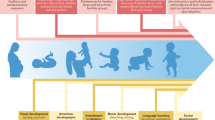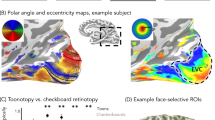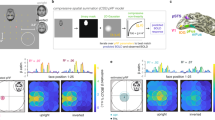Abstract
Adult expertise in face processing is mediated largely by neural networks in the right hemisphere. Here we evaluate the contribution of early visual input in establishing this neural substrate. We compared visually normal individuals to patients for whom visual input had been restricted mainly to one hemisphere during infancy. We show that early deprivation of visual input to the right hemisphere severely impairs the development of expert face processing, whereas deprivation restricted mainly to the left hemisphere does not. Our results indicate that the neural circuitry responsible for adults' face expertise is not pre-specified, but requires early visual experience. However, the two hemispheres are not equipotent: only the right hemisphere is capable of using the early input to develop expertise at face processing.
This is a preview of subscription content, access via your institution
Access options
Subscribe to this journal
Receive 12 print issues and online access
$209.00 per year
only $17.42 per issue
Buy this article
- Purchase on Springer Link
- Instant access to full article PDF
Prices may be subject to local taxes which are calculated during checkout



Similar content being viewed by others
References
Bruce, V. & Humphreys, G.W. Recognizing objects and faces. Vis. Cognit. 1, 141–180 (1994).
Maurer, D., Le Grand, R. & Mondloch, C.J. The many faces of configural processing. Trends Cogn. Sci. 6, 255–260 (2002).
Diamond, R. & Carey, S. Why faces are and are not special: an effect of expertise. J. Exp. Psychol. Gen. 115, 107–117 (1986).
Mondloch, C.J., Le Grand, R. & Maurer, D. The Development of Face Processing in Infancy and Early Childhood: Current Perspectives (eds. Pascalis, O. & Slater, A.) (Nova Science Publishers, New York, in press).
Kanwisher, N., McDermott, J. & Chun, M. The fusiform face area: a module in human extrastriate cortex specialized for face perception. J. Neurosci. 17, 4302–4311 (1997).
McCarthy, G., Puce, A., Gore, J.C. & Allison, T. Face-specific processing in the human fusiform gyrus. J. Cogn. Neurosci. 9, 605–610 (1997).
George, N. et al. Contrast polarity and face recognition in the human fusiform gyrus. Nat. Neurosci. 2, 574–580 (1999).
Rossion, B. et al. Hemispheric asymmetries for whole-based and part-based face processing in the human fusiform gyrus. J. Cogn. Neurosci. 12, 793–802 (2000).
de Renzi, E., Perani, D., Carlesimo, G.A., Silveri, M.C. & Fazio, F. Prosopagnosia can be associated with damage confined to the right hemisphere – an MRI and PET study and review of the literature. Neuropsychologia 32, 893–902 (1994).
Barton, J.J.S., Press, D.Z., Keenan, J.P. & O'Connor, M. Lesions of the fusiform face area impair perception of facial configuration in prosopagnosia. Neurology 58, 71–78 (2002).
Deruelle, C. & de Schonen, S. Do the right and left hemispheres attend to the same visuo-spatial information within a face in infancy? Dev. Neuropsychol. 14, 535–554 (1998).
Deruelle, C. & de Schonen, S. Pattern processing in infancy: Shape and location of components are not processed by the same hemisphere. Infant Behav. Dev. 18, 123–132 (1995).
de Schonen, S. & Mathivet, E. Hemispheric asymmetry in a face discrimination task in infants. Child Dev. 61, 1192–1205 (1990).
Farah, M., Rabinowitz, C., Quinn, G.E. & Liu, G.T. Early commitment of neural substrates for face recognition. Cognit. Neuropsychol. 17, 117–123 (2000).
Le Grand, R., Mondloch, C.J., Maurer, D. & Brent, H.P. Early visual experience and face processing. Nature 410, 890 (2001). Correction: Nature 412, 786 (2001).
Lewis, T.L. & Maurer, D. The development of temporal and nasal fields during infancy. Vision Res. 32, 903–911 (1990).
Deruelle, C. & de Schonen, S. Hemispheric asymmetries in visual pattern processing in infancy. Brain Cogn. 16, 151–179 (1991).
Liegeois, F. & de Schonen, S. Simultaneous attention in the two visual hemifields and interhemispheric integration: A developmental study on 20- to 26-month-old infants. Neuropsychologia 35, 381–385 (1997).
Liegeois, F., Bentejac, L. & de Schonen, S. When does inter-hemispheric integration of visual events emerge in infancy? A developmental study on 19- to 28-month old infants. Neuropsychologia 38, 1382–1389 (2000).
Crair, M.C., Gillespie, D.C. & Stryker, M.P. The role of visual experience in the development of columns in the cat visual cortex. Science 279, 566–570 (1998).
Weliky, M. & Katz, L.C. Correlational structure of spontaneous neuronal activity in the developing lateral geniculate nucleus in vivo. Science 285, 599–604 (1999).
Mondloch, C.J., Le Grand, R. & Maurer, D. Configural face processing develops more slowly than featural face processing. Perception 31, 553–566 (2002).
Freire, A., Lee, K. & Symons, L.A. The face-inversion effect as a deficit in the encoding of configural information: direct evidence. Perception 29, 159–170 (2000).
de Schonen, S. & Mathivet, E. First come, first served: a scenario about the development of hemispheric specialization in face recognition during infancy. Eur. Bull. Cognit. Psychol. 9, 3–44 (1989).
Sergent, J. Face perception and the right hemisphere. in Thought Without Language (ed. Weiskrantz, L.) 108–131 (Clarendon Press, Oxford, 1988).
Geldart, S. Experiential Influences on the Development of Face Perception. Thesis, McMaster Univ. (2000).
Maurer, D., Lewis, T.L. & Brent, H.P. The effects of deprivation on human visual development: studies of children treated for cataracts. in Applied Developmental Psychology Vol. 3 (eds. Morrison, F.J., Lord, C.E. & Keating, D.P.) 108–131 (Academic Press, San Diego, 1989).
Lewis, T.L. et al. Sensitivity to global form in glass patterns after early visual deprivation in humans. Vision Res. 42, 939–948 (2002).
Goldberg, M. Influence of Binocular Deprivation on the Development of Attention. Thesis, McMaster Univ. (1998).
Goldberg, M., Maurer, D. & Lewis, T.L. Developmental changes in attention: the effects of endogenous cueing and of distractors. Dev. Sci. 4, 209–219 (2001).
Goldberg, M., Maurer, D., Lewis, T.L. & Brent, H.P. The influence of binocular visual deprivation on the development of visual-spatial attention. Dev. Neuropsychol. 19, 53–81 (2001).
Nobre, A. et al. Functional localization of the system for visuospatial attention using postitron emission tomography. Brain 120, 515–533 (1997).
Gitelman, D. et al. A large-scale distributed network for covert spatial attention: further anatomical delineation based on stringent behavioral and cognitive controls. Brain 122, 1093–1106 (1999).
Gauthier, I., Skudkarski, P., Gore, J. & Anderson, A. Expertise for cars and birds recruits brain areas involved in face recognition. Nat. Neurosci. 3, 191–197 (2000).
Pascalis, O., de Schonen, S., Morton, J., Deruelle, C. & Fabre-Grenet, M. Mother's face recognition by neonates: a replication and an extension. Infant Behav. Dev. 18, 79–85 (1995).
Geldart, S., Mondloch, C.J., Maurer, D., de Schonen, S. & Brent, H.P. The effect of early visual deprivation on the development of face processing. Dev. Sci. 5, 490–501 (2002).
Ellemberg, D., Lewis, T.L., Maurer, D. & Brent, H.P. Influence of monocular deprivation during infancy on the later development of spatial and temporal vision. Vision Res. 40, 3283–3295 (2000).
Acknowledgements
This research was funded by grants to D.M. from the Natural Sciences and Engineering Research Council of Canada (NSERC) and the Social Sciences Research Council of Canada (SSHRC), and by a graduate scholarship to R.L. from NSERC. We thank the patients for their willingness to participate in the study, and A. Freire and K. Lee for providing face stimuli on which our stimulus sets were modeled.
Author information
Authors and Affiliations
Corresponding author
Ethics declarations
Competing interests
The authors declare no competing financial interests.
Supplementary information
Rights and permissions
About this article
Cite this article
Grand, R., Mondloch, C., Maurer, D. et al. Expert face processing requires visual input to the right hemisphere during infancy. Nat Neurosci 6, 1108–1112 (2003). https://doi.org/10.1038/nn1121
Received:
Accepted:
Published:
Issue Date:
DOI: https://doi.org/10.1038/nn1121
This article is cited by
-
Realness of face images can be decoded from non-linear modulation of EEG responses
Scientific Reports (2024)
-
Resting-State Activity in Children: Replicating and Extending Findings of Early Maturation of Alpha Rhythms in Autism Spectrum Disorder
Journal of Autism and Developmental Disorders (2023)
-
Congenitally blind adults can learn to identify face-shapes via auditory sensory substitution and successfully generalize some of the learned features
Scientific Reports (2022)
-
Neural specialization to human faces at the age of 7 months
Scientific Reports (2022)
-
Is human face recognition lateralized to the right hemisphere due to neural competition with left-lateralized visual word recognition? A critical review
Brain Structure and Function (2022)



